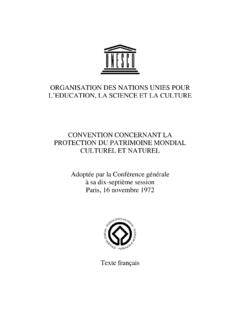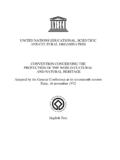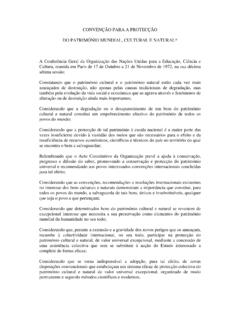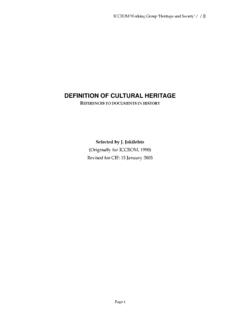Transcription of CONVENTION CONCERNING THE PROTECTION OF THE …
1 UNITED NATIONS EDUCATIONAL, SCIENTIFIC. AND CULTURAL ORGANISATION. CONVENTION CONCERNING THE. PROTECTION OF THE WORLD CULTURAL. AND NATURAL HERITAGE. Adopted by the General Conference at its seventeenth session Paris, 16 november 1972. English Text CONVENTION CONCERNING THE PROTECTION . OF THE WORLD CULTURAL AND NATURAL HERITAGE. The General Conference of the United Nations Educational, Scientific and Cultural Organization meeting in Paris from 17 October to 21 November 1972, at its seventeenth session, Noting that the cultural heritage and the natural heritage are increasingly threatened with destruction not only by the traditional causes of decay, but also by changing social and economic conditions which aggravate the situation with even more formidable phenomena of damage or destruction, Considering that deterioration or disappearance of any item of the cultural or natural heritage constitutes a harmful impoverishment of the heritage of all the nations of the world.
2 Considering that PROTECTION of this heritage at the national level often remains incomplete because of the scale of the resources which it requires and of the insufficient economic, scientific, and technological resources of the country where the property to be protected is situated, Recalling that the Constitution of the Organization provides that it will maintain, increase, and diffuse knowledge by assuring the conservation and PROTECTION of the world's heritage, and recommending to the nations concerned the necessary international conventions, Considering that the existing international conventions, recommendations and resolutions CONCERNING cultural and natural property demonstrate the importance, for all the peoples of the world, of safeguarding this unique and irreplaceable property, to whatever people it may belong, Considering that parts of the cultural or natural heritage are of outstanding interest and therefore need to be preserved as part of the world heritage of mankind as a whole, Considering that, in view of the magnitude and gravity of the new dangers threatening them, it is incumbent on the international community as a whole to participate in the PROTECTION of the cultural and natural heritage of outstanding universal value, by the granting of collective assistance which, although not taking the place of action by the State concerned, will serve as an efficient complement thereto.
3 Considering that it is essential for this purpose to adopt new provisions in the form of a CONVENTION establishing an effective system of collective PROTECTION of the cultural and natural heritage of outstanding universal value, organized on a permanent basis and in accordance with modern scientific methods, 1. Having decided, at its sixteenth session, that this question should be made the subject of an international CONVENTION , Adopts this sixteenth day of November 1972 this CONVENTION . I. DEFINITION OF THE CULTURAL AND NATURAL HERITAGE. Article 1. For the purpose of this CONVENTION , the following shall be considered as "cultural heritage": monuments: architectural works, works of monumental sculpture and painting, elements or structures of an archaeological nature, inscriptions, cave dwellings and combinations of features, which are of outstanding universal value from the point of view of history, art or science.
4 Groups of buildings: groups of separate or connected buildings which, because of their architecture, their homogeneity or their place in the landscape, are of outstanding universal value from the point of view of history, art or science;. sites: works of man or the combined works of nature and man, and areas including archaeological sites which are of outstanding universal value from the historical, aesthetic, ethnological or anthropological point of view. Article 2. For the purposes of this CONVENTION , the following shall be considered as "natural heritage": natural features consisting of physical and biological formations or groups of such formations, which are of outstanding universal value from the aesthetic or scientific point of view;. geological and physiographical formations and precisely delineated areas which constitute the habitat of threatened species of animals and plants of outstanding universal value from the point of view of science or conservation.
5 Natural sites or precisely delineated natural areas of outstanding universal value from the point of view of science, conservation or natural beauty. 2. Article 3. It is for each State Party to this CONVENTION to identify and delineate the different properties situated on its territory mentioned in Articles 1 and 2 above. II. NATIONAL PROTECTION AND international PROTECTION OF THE. CULTURAL AND NATURAL HERITAGE. Article 4. Each State Party to this CONVENTION recognizes that the duty of ensuring the identification, PROTECTION , conservation, presentation and transmission to future generations of the cultural and natural heritage referred to in Articles 1 and 2 and situated on its territory, belongs primarily to that State. It will do all it can to this end, to the utmost of its own resources and, where appropriate, with any international assistance and co-operation, in particular, financial, artistic, scientific and technical, which it may be able to obtain.
6 Article 5. To ensure that effective and active measures are taken for the PROTECTION , conservation and presentation of the cultural and natural heritage situated on its territory, each State Party to this CONVENTION shall endeavor, in so far as possible, and as appropriate for each country: (a) to adopt a general policy which aims to give the cultural and natural heritage a function in the life of the community and to integrate the PROTECTION of that heritage into comprehensive planning programmes;. (b) to set up within its territories, where such services do not exist, one or more services for the PROTECTION , conservation and presentation of the cultural and natural heritage with an appropriate staff and possessing the means to discharge their functions;. (c) to develop scientific and technical studies and research and to work out such operating methods as will make the State capable of counteracting the dangers that threaten its cultural or natural heritage.
7 (d) to take the appropriate legal, scientific, technical, administrative and financial measures necessary for the identification, PROTECTION , conservation, presentation and rehabilitation of this heritage; and 3. (e) to foster the establishment or development of national or regional centres for training in the PROTECTION , conservation and presentation of the cultural and natural heritage and to encourage scientific research in this field. Article 6. 1. Whilst fully respecting the sovereignty of the States on whose territory the cultural and natural heritage mentioned in Articles 1 and 2 is situated, and without prejudice to property right provided by national legislation, the States Parties to this CONVENTION recognize that such heritage constitutes a world heritage for whose PROTECTION it is the duty of the international community as a whole to co-operate.
8 2. The States Parties undertake, in accordance with the provisions of this CONVENTION , to give their help in the identification, PROTECTION , conservation and presentation of the cultural and natural heritage referred to in paragraphs 2 and 4 of Article 11 if the States on whose territory it is situated so request. 3. Each State Party to this CONVENTION undertakes not to take any deliberate measures which might damage directly or indirectly the cultural and natural heritage referred to in Articles 1 and 2 situated on the territory of other States Parties to this CONVENTION . Article 7. For the purpose of this CONVENTION , international PROTECTION of the world cultural and natural heritage shall be understood to mean the establishment of a system of international co- operation and assistance designed to support States Parties to the CONVENTION in their efforts to conserve and identify that heritage.
9 III INTERGOVERNMENTAL COMMITTEE FOR THE PROTECTION OF THE. WORLD CULTURAL AND NATURAL HERITAGE. Article 8. 1. An Intergovernmental Committee for the PROTECTION of the Cultural and Natural Heritage of Outstanding Universal Value, called "the World Heritage Committee", is hereby established within the United Nations Educational, Scientific and Cultural Organization. It shall be composed of 15 States Parties to the CONVENTION , elected by States Parties to the CONVENTION meeting in general assembly during the ordinary session of the General Conference of the United Nations Educational, Scientific and Cultural Organization. The number of States members of the Committee shall be increased to 21 as from the date of the ordinary session of the General Conference following the entry into force of this CONVENTION for at least 40 States.
10 4. 2. Election of members of the Committee shall ensure an equitable representation of the different regions and cultures of the world. 3. A representative of the international Centre for the Study of the Preservation and Restoration of Cultural Property (Rome Centre), a representative of the international council of monuments and sites (ICOMOS) and a representative of the international Union for Conservation of Nature and Natural Resources (IUCN), to whom may be added, at the request of States Parties to the CONVENTION meeting in general assembly during the ordinary sessions of the General Conference of the United Nations Educational, Scientific and Cultural Organization, representatives of other intergovernmental or non-governmental organizations, with similar objectives, may attend the meetings of the Committee in an advisory capacity.







